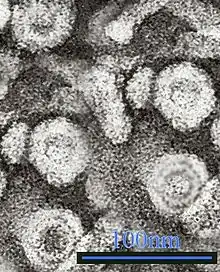Orthohepadnavirus
Orthohepadnavirus is a genus of viruses, in the family Hepadnaviridae.[1] Humans and other mammals serve as natural hosts. There are currently 12 species in this genus including the type species Hepatitis B virus.[1] Diseases associated with this genus include: hepatitis, hepatocellular carcinoma (chronic infections), and cirrhosis.[1][2]
| Orthohepadnavirus | |
|---|---|
 | |
| TEM micrograph showing Hepatitis B virus virions | |
| Virus classification | |
| (unranked): | Virus |
| Realm: | Riboviria |
| Kingdom: | Pararnavirae |
| Phylum: | Artverviricota |
| Class: | Revtraviricetes |
| Order: | Blubervirales |
| Family: | Hepadnaviridae |
| Genus: | Orthohepadnavirus |
| Type species | |
| Hepatitis B virus | |
| Species | |
| |
Structure
Viruses in the genus Orthohepadnavirus are enveloped, with spherical geometries, and T=4 symmetry. The diameter is around 42 nm. Genomes are circular, around 3.2kb in length. The genome codes for 7 proteins.[1] [2]
| Genus | Structure | Symmetry | Capsid | Genomic arrangement | Genomic segmentation |
|---|---|---|---|---|---|
| Orthohepadnavirus | Icosahedral | T=4 | Non-enveloped | Circular | Monopartite |
Life cycle
Viral replication is nucleo-cytoplasmic. Replication follows the dsDNA(RT) replication model. DNA-templated transcription, specifically dsDNA(RT) transcription, with some alternative splicing mechanism is the method of transcription. Translation takes place by leaky scanning. The virus exits the host cell by budding, and nuclear pore export. Human and mammals serve as the natural host. Transmission routes are sexual, blood, and contact.[1] [2]
| Genus | Host details | Tissue tropism | Entry details | Release details | Replication site | Assembly site | Transmission |
|---|---|---|---|---|---|---|---|
| Orthohepadnavirus | Humans; mammals | Hepatocytes | Cell receptor endocytosis | Budding | Nucleus | Cytoplasm | Vertical: parental; sex; blood |
References
- "ICTV Report Hepadnaviridae".
- "Viral Zone". ExPASy. Retrieved 15 June 2015.